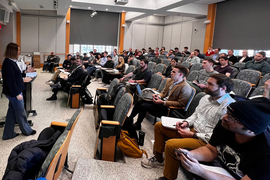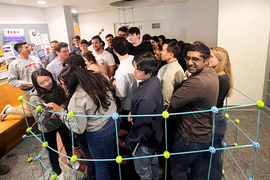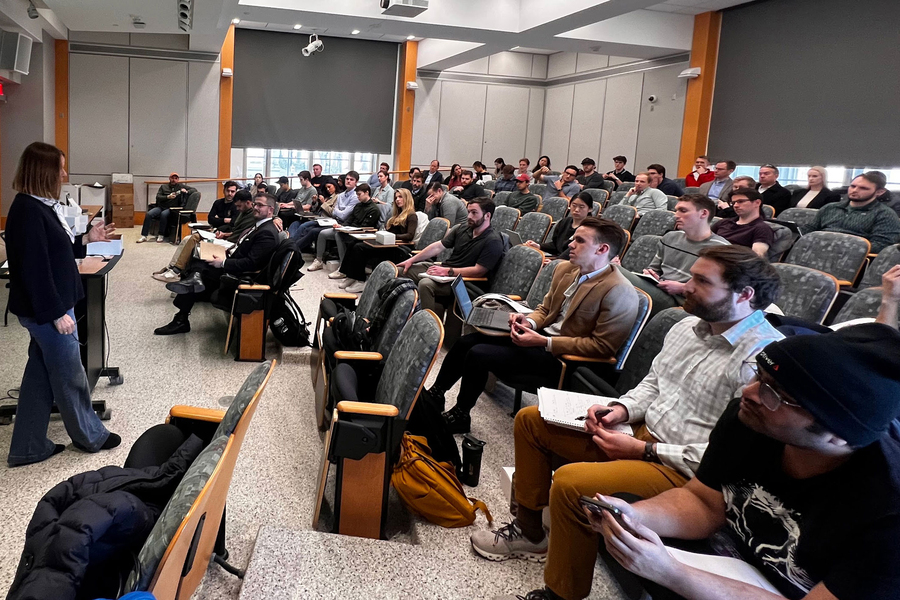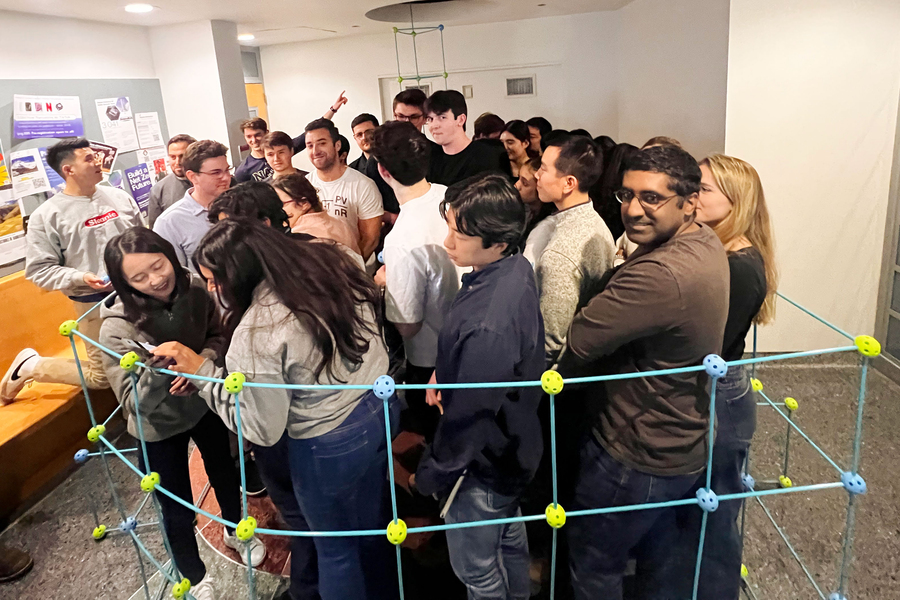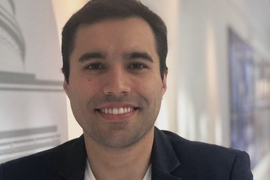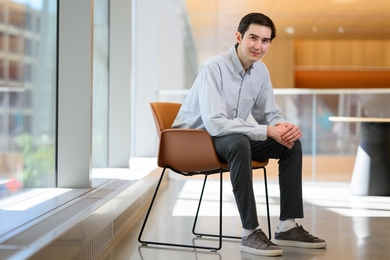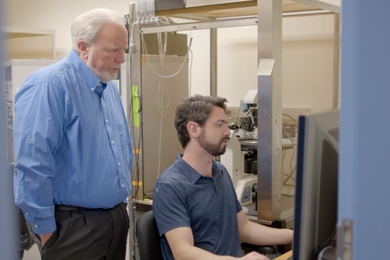On a recent Friday afternoon, Marine Corps Major and U.S. Congressman Jake Auchincloss stood in the front of a crowded MIT classroom in Building 1 and made his case for modernizing America’s military to counter the threat from China. Part of his case involved shifting resources away from the U.S. Army to bolster the Marines, Navy, and Air Force.
When it was time for questions, several hands shot up. One person took exception to Auchincloss’ plans for the Army, although he admitted his views were influenced by the fact that he was an active member of the Army’s Special Forces. Another person had a question about the future of wartime technology. Again, the questioner had some personal experience: He sits on the board of a Ukrainian drone-manufacturing company. Next up was an MIT student with a question about artificial intelligence.
Course 15.362/6.9160 (Engineering Innovation: Global Security Systems) is not your typical MIT class. It teaches students about the most pressing problems in global security and challenges them to build functioning prototypes over the course of one whirlwind semester. Along the way, students hear from high-ranking members of the military, MIT professors, government officials, startup founders, and others to learn about the realities of combat and how best to create innovative solutions.
“In this course, the Navy SEALs are in the classroom working directly with the students. By teaching students in this way, we’re giving them exposure to something they’d never otherwise be exposed to,” says Gene Keselman MBA ’17, a lecturer in the MIT Sloan School of Management and a colonel in the U.S. Air Force Reserves who helped start the class.
In the beginning of the semester, students split into interdisciplinary groups that feature both undergraduate and graduate students. Each group is assigned mentors with deep military experience. From there, students learn to take a problem, map out a set of possible solutions, and pitch their prototypes to the active members of the armed services they’re trying to help.
They get feedback on their ideas and iterate as they go through a series of presentation milestones throughout the semester.
“The outcomes are twofold,” says A.J. Perez ’13, MEng ’14, PhD ’23, a lecturer in the MIT School of Engineering and a research scientist with the Office of Innovation, who built the course’s engineering design curriculum. “There are the prototypes, which could have real impact on war fighters, and then there are the learnings students get by going through the process of defining a problem and building a prototype. The prototype is important, but the process of the class leads to skills that are transferable to a multitude of other domains.”
The class’s organizers say although the course is only in its second year, it aligns with MIT’s long legacy of working alongside the military.
“MIT has these incredibly fruitful relationships with the Department of Defense going back to World War II,” says Keselman. “We developed advanced radar systems that helped win the war and launched the military-industrial complex, including organizations like MIT Lincoln Laboratory and MITRE. It’s in our ethos, it’s in our culture, and this is another extension of that. This is another way for MIT to lead in tough tech and work on the world’s hardest problems. We couldn’t do this class in another university in this country.”
Tapping into student interest
Like many things at MIT, the class was inspired by a hackathon. For several years, college students in the U.S. Armed Forces’ Reserve Officers’ Training Corps (ROTC) program came to MIT from across the country for a weekend hackathon focused on solving specific military problems.
Last year, Keselman, Perez, and others decided to create the class to give MIT’s ROTC cadets more time to work on the projects and give them the opportunity to earn course credit. But when Keselman and Perez announced a class geared toward solving problems in the armed forces, many non-ROTC MIT students enrolled.
“We realized there was a lot of interest in national security at MIT beyond the ROTC cadets,” Keselman explains. “National security is obviously important to a lot of people, but it also offers super interesting problems you can’t find anywhere else. I think that attracted students from all over MIT.”
About 25 students enrolled the first year to work on a problem that prevented U.S. Navy SEALs from bringing lithium-ion batteries onto submarines. This year, the organizers who include senior faculty members Fiona Murray, Sertac Karaman, and Vladimir Bulovic, couldn’t fit everyone who showed up, so they expanded to room 1-190, a lecture hall. They also added graduate-level credits and were more prepared for student interest.
More than 70 students registered this year from 15 different MIT departments, Harvard College, the Harvard Business School, and the Harvard Kennedy School. Student groups contain undergraduates, graduates, engineers, and business students. Many have military experience, and each group has access to mentors from places including the Navy, Air Force, Special Operations, and the Massachusetts State Police.
“Last year a student said, ‘This class is weird, and that’s exactly why it needs to stick around,’” Keselman says. “It is weird. It’s not normal for this many disciplines to come together, to have a Congressman showing up, Navy Seals, and members of the Army’s Special Forces all sitting in a room. Some are active-duty students, some are mentors, but it’s an incredible melting pot. I think it’s exactly what MIT embodies.”
From projects to military programs
This year’s class project challenges students to develop countermeasures for autonomous drone systems, which either travel by air or sea. Over the course of the semester, teams have built solutions that achieve early drone detection, categorization, and countermeasures. The solutions also must integrate AI and consider domestic manufacturing capabilities and supply chains.
One group is using sensors to detect the auditory signature of drones in the air. In the class, they gave a live demo that would only signal a threat when it detected a certain steady pitch associated with the electric motor of an air drone.
“Nothing motivates MIT students like a problem in the real world that they know really matters,” Perez says. “At the core of this year’s problem is how we protect a human from a drone attack. They take the process seriously.”
Organizers have also talked about extending the class into a year-long program that would allow the teams to build their projects into real products in partnership with groups at places like Lincoln Laboratory.
“This class is spreading the seeds of collaboration between academia and government,” Keselman says. “It’s a true partnership as opposed to just a funding program. Government officials come to MIT and sit in the classroom and see what’s actually happening here — and they rave about how impressive all the work is.”
